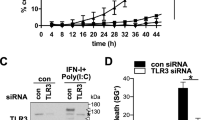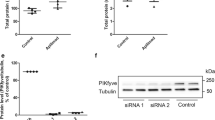Abstract
The tumor suppressor function of PTEN is attributed to its phospholipid phosphatase activity that dephosphorylates the plasma membrane phosphatidylinositol-(3,4,5)-triphosphate [PtdIns(3,4,5)P3]. Implicit in this notion is that PTEN needs to be targeted to the plasma membrane to dephosphorylate PtdIns(3,4,5)P3. However, the recruitment of PTEN to the plasma membrane is not fully understood. Here, we demonstrate PTEN accumulation in the detergent-insoluble fraction of neuronal cells in response to treatment by the proteasome inhibitor lactacystin. First, lactacystin induces apoptosis and the activation of caspase-3 in cultured cortical neurons. Second, PTEN undergoes proteolysis to form a truncated 50-kDa form that lacks parts of its C-terminal tail. Third, the truncated PTEN is stably associated with the detergent-insoluble fraction in which the plasma membrane marker protein flotillin-1 resides. Taken together, our results suggest that truncation and accumulation of PTEN to the detergent- insoluble membrane fraction are two events associated with the apoptotic signals of the proteasome inhibitor in cortical neurons.
Similar content being viewed by others
References
Leslie N. R. and Downes C. P. (2002) The down side of PI3-kinase signalling. Cell. Signal. 14: 285–295
Waite K. A. and Eng C. (2002) Protean PTEN: form and function. Am. J. Hum. Genet. 70: 829–844
Wang X., Gjörloff-Wingre A., Saxena M., Pathan N., Reed J.C. and Mustelin T. (1999) The tumor suppressor PTEN regulates T cell survival and antigen receptor signalling by acting as a phosphatidylinositol 3-phosphate. J. Immunol. 164: 1934–1939
Gary D. S. and Mattson M. P. (2002) PTEN regulates Akt kinase activity in hippocampal neurons and increases their sensitivity to glutamate and apoptosis. Neuromol. Med. 2: 261–269
Das S., Dixon J. E. and Cho W. (2003) Membrane-binding and activation mechanism of PTEN. Proc. Natl. Acad. Sci. USA 100: 7491–7496
Georgescu M., Kirsch K. H., Akagi T., Shishido T. and Hanafusa H. (1999) The tumor-suppressor activity of PTEN is regulated by its carboxyl-terminal region. Proc. Natl. Acad. Sci. USA 96: 10182–10187
Leslie N. R., Bennett D., Gray A., Pass I., Khe H-X. and Downes P. (2001) Targeting mutants of PTEN reveal distinct subsets of tumour suppressor functions. Biochem. J. 357: 427–435
Lachyanker M. B., Sultana N., Schonhoff C. M., Mitra P., Poluha W., Lambert S. et al. (2000) A role for nuclear PTEN in neuronal differentiation. J. Neurosci. 20: 1404–1413
Keller J. N., Hanni K. B. and Markesbery W. R. (2000) Impaired proteasome function in Alzheimer's disease. J. Neurochem. 75: 436–439
Naujokat C. and Hoffmann S. (2002) Role and function of the 26S proteasome in proliferation and apoptosis. Lab. Invest. 82: 965–980
Halliwell B. (2002) Hypothesis: proteasomal dysfunction: a primary event in neurogeneration that leads to nitrative and oxidative stress and subsequent cell death. Ann. N. Y. Acad. Sci. 962: 182–194
Qiu J. H., Asai A., Chi S., Saito N., Hamada H. and Kirino T. (2000) Proteasome inhibitors induce cytochrome c-caspase-3-like protease-mediated apoptosis in cultured cortical neurons. J. Neurosci. 20: 259–265
Pasquini L. A., Moreno M. B., Adamo A. M., Pasquini J. M. and Soto E. F. (2000) Lactacystin, a specific inhibitor of the proteasome, induces apoptosis and activates caspase-3 in cultured cerebellar granule cells. J. Neurosci. Res. 59: 601–611
Cheung N. S., Pascoe C. J., Giardina S. F., John C. A. and Beart P. M. (1998) Micromolar L-glutamate induces extensive apoptosis in an apoptotic-necrotic continuum of insult-dependent, excitotoxic injury in cultured cortical neurons. Neuropharmacology 37: 1419–1429
Cheung N. S., Beart P. M., Pascoe C. J., John C. A. and Bernard O. (2000) Human Bcl-2 protects against AMPA receptor-mediated apoptosis. J. Neurochem. 74: 1613–620
Smart E. J., Ying Y. S., Mineo C. and Anderson R. G. W. (1995) A detergent-free method for purifying caveolae membrane from tissue culture cells. Proc. Natl. Acad. Sci. USA 92: 10104–10108
Luukko K., Ylikorkala A., Tiainen M. and Mäkelä T. P. (1999) Expression of LKB1 and PTEN tumor suppressor genes during mouse embryonic development. Mech. Dev. 83: 187–190
Torres J., Rodriguez J., Myers M. P., Valiente M., Graves J. D., Tonks N. K. et al. (2003) Phosphorylation-regulated cleavage of the tumor suppressor PTEN by caspase-3: implications for the control of protein stability and PTEN-protein interactions. J. Biol. Chem. 278: 30652–30660
Author information
Authors and Affiliations
Corresponding author
Rights and permissions
About this article
Cite this article
Cheung, N.S., Choy, M.S., Halliwell, B. et al. Lactacystin-induced apoptosis of cultured mouse cortical neurons is associated with accumulation of PTEN in the detergent-resistant membrane fraction. Cell. Mol. Life Sci. 61, 1926–1934 (2004). https://doi.org/10.1007/s00018-004-4127-7
Received:
Revised:
Accepted:
Published:
Issue Date:
DOI: https://doi.org/10.1007/s00018-004-4127-7




